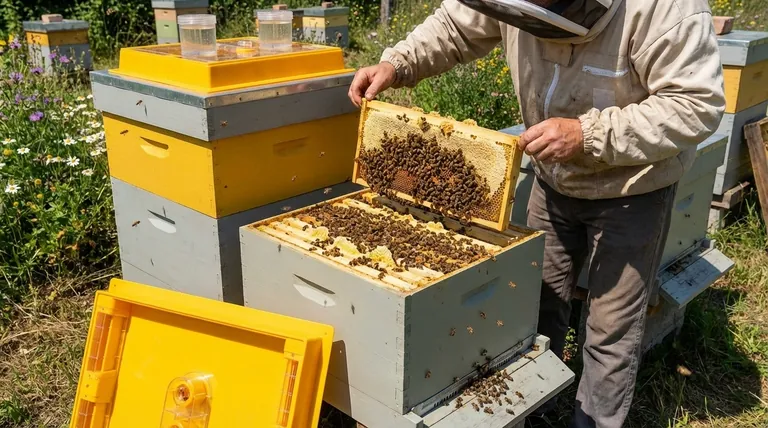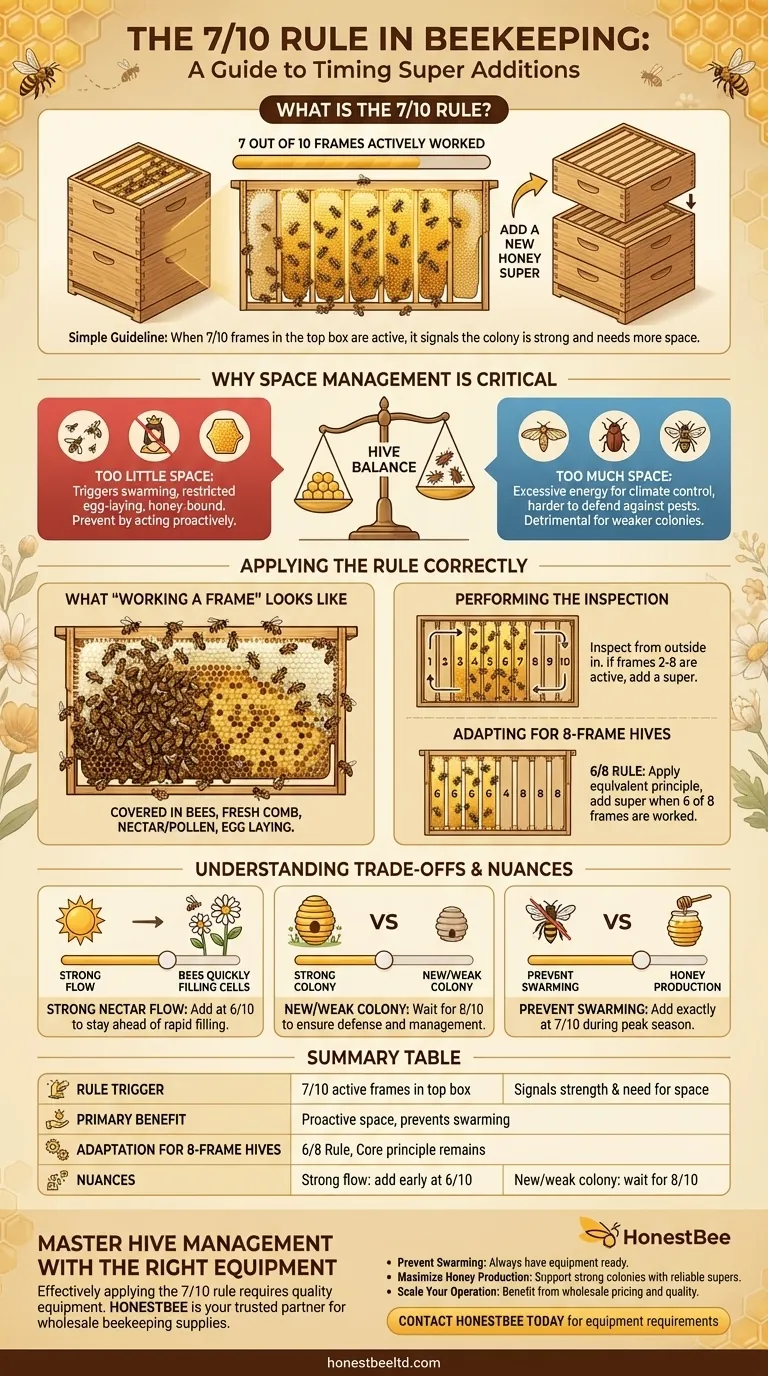The 7/10 rule in beekeeping is a simple guideline: you should add a new honey super when your bees have drawn out comb and are actively working on seven out of the ten frames in the uppermost box. This rule provides a clear signal that the colony is growing strong and will soon run out of space for both brood and honey storage.
The 7/10 rule is less a strict command and more a critical indicator of hive congestion. Following it helps you provide more space proactively, which is the single most important action you can take to prevent swarming and ensure uninterrupted honey production.

Why Space Management is Critical
A beehive is a finely balanced system, and the amount of available space is a key variable. The 7/10 rule is simply a tool to help you manage that variable effectively.
The Dangers of Too Little Space
When a hive becomes too crowded, it triggers the colony's natural reproductive instinct: swarming. The queen's egg-laying becomes restricted, and worker bees run out of cells to store incoming nectar.
This "honey-bound" or "brood-bound" state signals to the bees that it's time to divide the colony. Providing more space before this happens is the most effective way to keep your productive workforce in the hive.
The Problems with Too Much Space
Conversely, adding a super too early can be detrimental. Giving a colony too much empty space forces them to expend excessive energy on temperature and humidity control.
This vast, unpopulated area is also difficult for the bees to defend. It can become an inviting target for pests like wax moths and small hive beetles, creating stress and potential devastation for a colony that isn't strong enough to patrol it.
Applying the 7/10 Rule Correctly
Observing the rule is straightforward, but it requires understanding what to look for during an inspection.
What "Working on a Frame" Looks Like
"Working" a frame means more than just having a few bees walking across it. You are looking for frames that are covered in bees.
On these frames, you should see evidence of significant work: freshly drawn white wax comb, cells being filled with nectar, pollen being stored, or the queen laying eggs (in the brood boxes). The outer frames (1 and 10) are often the last to be used.
Performing the Inspection
Start your inspection from one of the outer frames and move inward. If you see that frames 2 through 8 are covered with bees and actively being used, you have met the 7/10 threshold. It is time to add another super.
Adapting for 8-Frame Hives
The principle remains identical for hives with different frame counts. If you are using 8-frame equipment, the equivalent guideline would be the "6/8 Rule." Once six of the eight frames are being actively worked, it's time to add more space.
Understanding the Trade-offs and Nuances
The 7/10 rule is an excellent starting point, but an experienced beekeeper learns to adapt it based on other environmental and colony-specific factors.
It's a Guideline, Not a Law
Think of the rule as an alert, not an absolute command. Your judgment as the beekeeper is the most important factor. Consider the time of year and the availability of resources before making a decision.
The Impact of Nectar Flow
The nectar flow—the period when nectar-producing plants are in bloom—is the most critical variable. During a very strong flow, bees can fill a super with shocking speed. In this scenario, you might add a super when only 6 of 10 frames are drawn to stay ahead of their progress.
Conversely, if you know a nectar dearth (a period of low resources) is approaching, you might wait until 8 or 9 frames are full, as the bees' expansion will slow down naturally.
Colony Strength and Age
A new, small colony or a package installed this year will build up more slowly than a powerful, overwintered colony. Be more conservative with new colonies, as giving them too much space can easily overwhelm them. A booming, established hive may require you to apply the 7/10 rule more aggressively to prevent swarming.
How to Apply This to Your Goal
Use the 7/10 rule as a foundation for your hive management strategy, adjusting based on your primary objective.
- If your primary focus is preventing swarming: Add the super as soon as you hit the 7/10 mark, especially during peak season, to give the queen and workers ample space.
- If your primary focus is maximizing honey production: Add the super slightly ahead of the curve (at 6/10) if you know a strong nectar flow is imminent.
- If you are managing a new or weaker colony: Be more cautious and wait until they are actively using 8 of the 10 frames to ensure they can defend and manage the new space.
Ultimately, the 7/10 rule is your tool for interpreting the colony's needs and responding proactively to keep your bees healthy and productive.
Summary Table:
| Key Aspect | What to Look For | Why It Matters |
|---|---|---|
| Rule Trigger | 7 out of 10 frames in the top box are covered in bees and actively used. | Signals the colony is strong and needs more space to prevent congestion. |
| Primary Benefit | Proactively provides space before the hive becomes honey-bound or brood-bound. | This is the single most effective action to prevent swarming. |
| Adaptation for 8-Frame Hives | Apply the "6/8 Rule"—add a super when 6 of 8 frames are actively worked. | The core principle remains the same for different hive configurations. |
| Nuance: Strong Nectar Flow | Consider adding a super at 6/10 frames to stay ahead of rapid honey storage. | Prevents the bees from running out of space during a heavy nectar flow. |
| Nuance: New/Weak Colony | Wait until 8/10 frames are used before adding a super. | Avoids giving a small colony too much difficult-to-defend space. |
Master Hive Management with the Right Equipment
Effectively applying the 7/10 rule requires a steady supply of high-quality supers and frames to support your colony's growth. HONESTBEE is your trusted partner, supplying durable, well-crafted beekeeping supplies and equipment to commercial apiaries and beekeeping equipment distributors through our wholesale-focused operations.
We help you:
- Prevent Swarming: Ensure you always have the necessary equipment on hand to add space at the critical moment.
- Maximize Honey Production: Support strong, healthy colonies with reliable supers and foundation.
- Scale Your Operation: Benefit from wholesale pricing and consistent quality for all your beekeeping needs.
Ensure your hives have the space they need to thrive. Contact HONESTBEE today to discuss your equipment requirements and keep your colonies productive.
Visual Guide

Related Products
- Professional Hive Top Bee Feeder for Beekeeping
- In-Hive Dual Compartment Frame Bee Feeder for Targeted Colony Nutrition
- HONESTBEE Professional Entrance Bee Feeder Hive Nutrition Solution
- Wooden Bee Brush with Double-Row Horsehair Bristles
- Boardman Entrance Bee Feeder Durable Galvanized Steel and Wood Construction for Beekeeping
People Also Ask
- Why is a top feeder essential for bees? Ensure Colony Health and Efficiency
- What are the advantages of hive top feeders? Maximize Feeding Efficiency for Your Apiary
- What is the best bee feeder for a hive? Choose the Right Feeder for Your Apiary's Scale
- How to use a top feeder in a beehive? A Guide to Effective Beehive Feeding
- Do I need an inner cover with a hive top feeder? Optimize Your Hive Setup for Healthy Bees



















